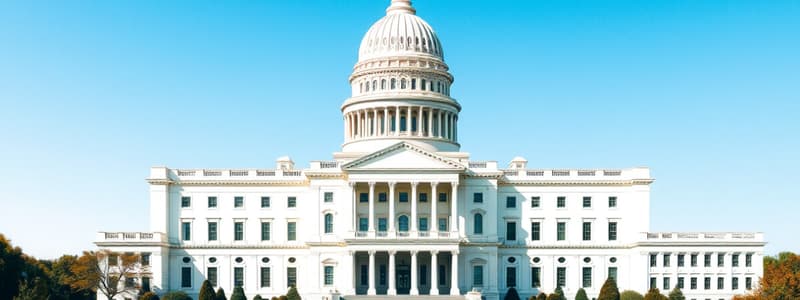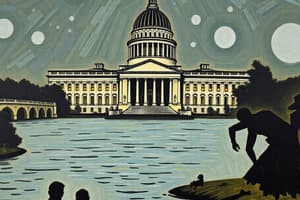Podcast
Questions and Answers
What is an independent agency?
What is an independent agency?
Independent agencies are outside of the executive branch and are not under the supervision of the president. They were created by Congress to deal with complex matters.
Who are the heads of independent agencies?
Who are the heads of independent agencies?
The heads of most independent agencies are a commission or collegial group, rather than a single individual.
How can heads of independent agencies be removed?
How can heads of independent agencies be removed?
Heads are typically removable only for cause, as noted in Humphrey's Executor.
What do independent agencies do?
What do independent agencies do?
How is an independent agency created?
How is an independent agency created?
What problems are there with how independent agencies are created?
What problems are there with how independent agencies are created?
There is a potential violation of the separation of powers with how independent agencies are created.
There is a potential violation of the separation of powers with how independent agencies are created.
How did Humphrey's Executor lead to independent agencies?
How did Humphrey's Executor lead to independent agencies?
How did Humphrey's Executor impact the removal of agency officers?
How did Humphrey's Executor impact the removal of agency officers?
How can the president remove the head of an independent agency?
How can the president remove the head of an independent agency?
Why are independent agencies usually headed by commissions rather than individuals?
Why are independent agencies usually headed by commissions rather than individuals?
Why are commissions a special problem when the White House changes parties after a two-term president?
Why are commissions a special problem when the White House changes parties after a two-term president?
Flashcards are hidden until you start studying
Study Notes
Independent Agencies Overview
- Independent agencies operate outside the executive branch and are not directly supervised by the president.
- Their creation is primarily the responsibility of Congress to handle complex regulatory matters.
Leadership Structure
- Most independent agencies are headed by a commission or collegial body rather than a single individual.
- The terms of agency heads are staggered to overlap with presidential terms, promoting continuity and reducing partisan influence.
Removal of Agency Heads
- Agency heads are generally removable only "for cause," as established in Humphrey's Executor case.
- Presidential removal powers over agency heads are restricted by Congress, unlike executive agency heads who serve at presidential discretion.
Functions of Independent Agencies
- They perform quasi-judicial and quasi-legislative functions, possessing regulatory power equivalent to federal law.
- Their regulations have a significant impact on various sectors, reflecting their authority.
Creation and Legislative Concerns
- Independent agencies are established through enabling statutes passed by Congress.
- Concerns arise from Congress delegating executive functions to these agencies, paralleling the "Browshar issue."
Separation of Powers Issues
- Their structure raises potential separation of powers violations by concentrating quasi-legislative and quasi-judicial powers in a single agency.
- This consolidation threatens the principle of checks and balances designed to prevent power concentration and ensure accountability.
Significance of Humphrey's Executor Case
- The 1935 Humphrey's Executor case established constitutional support for limiting presidential removal power over independent agency officials.
- It underscored the need for agencies to operate independently from political pressure, particularly from the presidency.
Presidential Influence and Term Overlap
- Heads of independent agencies have staggered terms that can overlap with presidential terms, limiting the president's influence over agency leadership.
- The removal of heads is governed by standards set in landmark cases like Weiner and Humphrey's Executor.
Commission Structure and Political Diversity
- Independent agencies are typically led by multi-member commissions to promote political balance and avoid dominance by any one political party.
- Members serve staggered terms and can be removed only for cause to ensure fair representation and efficacy.
Challenges During Party Transitions
- When presidential administrations change, appointed commissioners may extend beyond the president's term, complicating new appointments.
- The staggered and longer terms of commissioners inhibit a president from appointing all members of an independent agency.
Studying That Suits You
Use AI to generate personalized quizzes and flashcards to suit your learning preferences.




